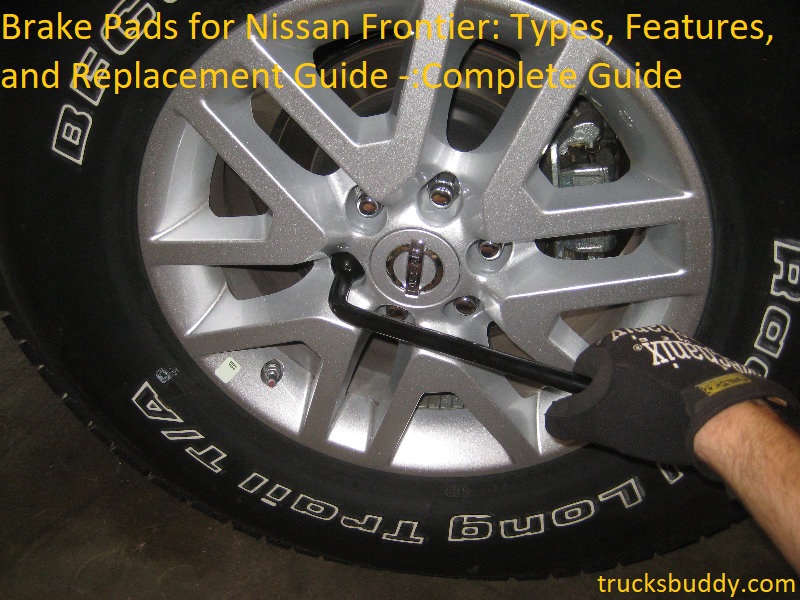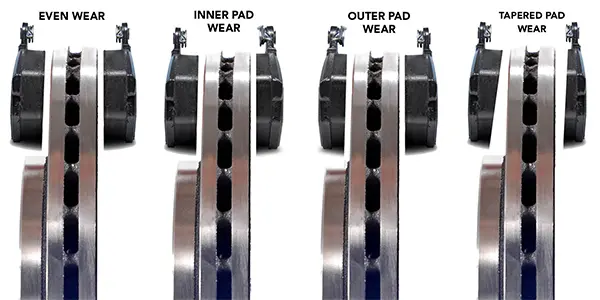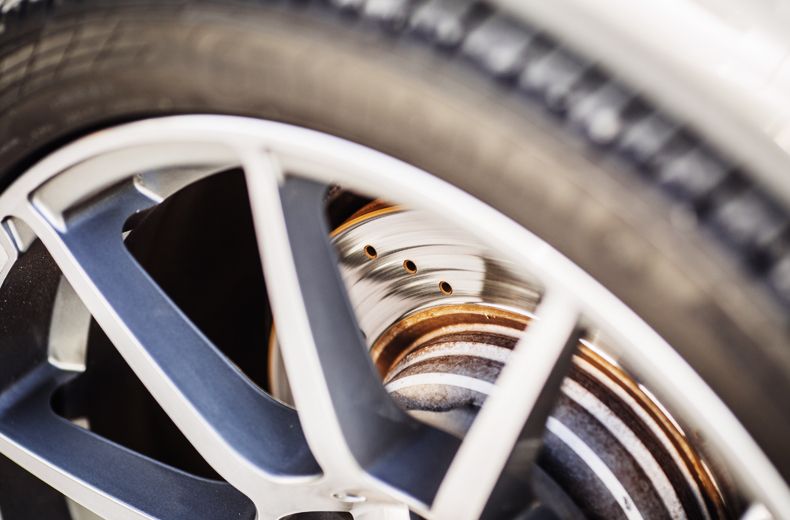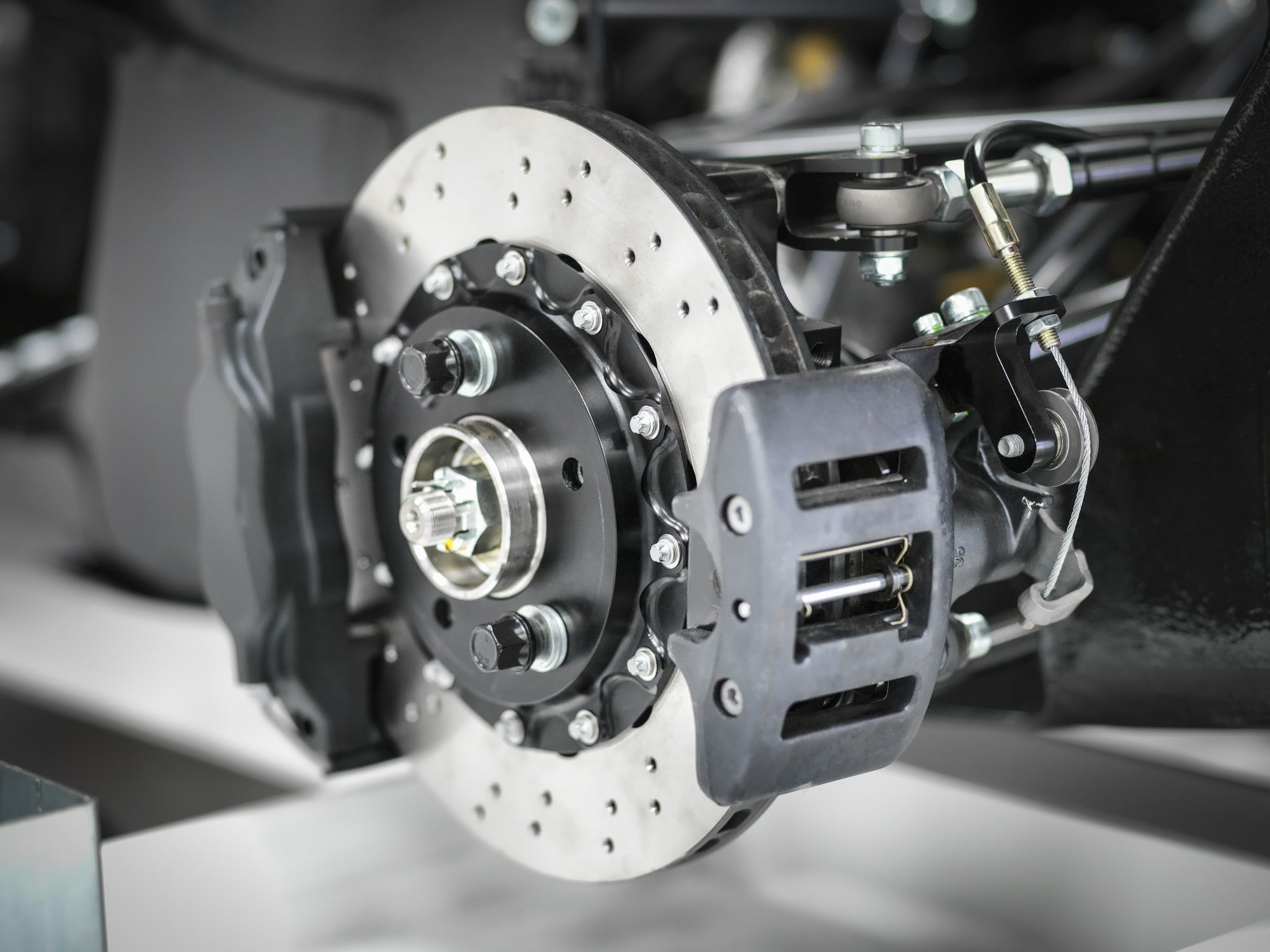Are you tired of squeaky brakes in your Nissan Frontier? Brake pads absorb the heat and friction generated while braking to ensure your safety on the road.
In this article, you will learn about different brake pads for your Nissan Frontier and a complete guide to replacing them. Discover the right types of brake pads to enhance your vehicle’s performance and driving experience!
The brakes on your Nissan Frontier are an important component in the vehicle’s overall safety. Brake pads help control the speed and direction of your vehicle, while reducing wear on other parts, such as the rotors. However, over time these components can become worn out, making it necessary to replace them in order to keep your car running safely.
Knowing which type of brake pads are suitable for your Nissan Frontier model and how to replace them is key to keeping your car in top condition. In this guide, we’ll provide an outline on the different types of brake pads available for a Nissan Frontier and the features that come with each one. We’ll also explain how to check for worn out brake pads and offer tips on how to replace or upgrade them as needed.

Features of Brake Pads for Nissan Frontier
Selecting the right brake pads for your Nissan Frontier is an important decision to make, as these components are responsible for stopping the vehicle and providing superior performance on the road. With that in mind, familiarizing yourself with some of the features and specifications of brake pads for Nissan Frontier can be useful in making an informed decision.
First, be sure to review basic information such as size, number of pieces per set, type and brand of brakes. Type is important to consider when choosing brakes since there are many options that can affect performance on different roads, including ceramic, drum brakes, organic and semi-metallic pads.
In addition to size and type considerations when selecting brake pads for your Nissan Frontier, it is also important to review any additional features they may offer such as dustless technology or low noise levels. For improved stopping power on wet roads or difficult terrain conditions, look into more advanced materials such as ceramic or metallic brake pads as well as reinforced hardware components.
It’s also worth noting that many automotive parts stores offer their own brand of aftermarket brake pads for a Nissan Frontier which may provide increased performance at a lower cost compared to original equipment manufacturer (OEM) parts from a dealership. When reviewing aftermarket parts stores or third party websites selling brake pads for your Nissan Frontier make sure you read customer reviews about compatibility and quality closely before purchasing any items.
Noise reduction
The right type of brake pads can help significantly reduce the noise that your Nissan Frontier is making while braking. Here are some common features you should look for when selecting a replacement set of brake pads:
- Noise-reducing technology: Some brake pads have built-in sound absorbing layers to reduce noise. They also often have slots, perforations and grooves to help dissipate heat, water and debris. This can help reduce vibration and noise as well.
- Shimmed and slotted designs: These designs are designed to dampen vibrations – reducing noise further and improving your overall ride experience. Check the product description to make sure that there is a shim or slot construction in the middle of each pad on the backing plate or surface that contacts the rotor disc.
- Ceramic materials: Many brake pad sets manufacturers include ceramic materials in their design which helps absorb sound and heat from braking. Be sure to keep an eye out for ceramic construction – it can provide top-notch performance!
- Rubber insulation strips: Rubber insulation strips do just what their name implies – they insulate! By dampening vibrations created during braking, they can lessen the amount of noise you hear in your car.
Ensuring that you select a high-quality, noise reducing brake pad set will help keep your Nissan Frontier running smoothly and quietly while maintaining excellent performance levels at all times.
Durability
Durability is one of the most important features to consider when selecting brake pads for a Nissan Frontier. The material used in the construction of a brake pad plays a major role in how long it will last. There are several materials available, but broadly speaking they can be divided into two groups – organic and sintered.
Organic Brake Pads: Organic brake pads are composed of materials such as Kevlar, aramid fibers and rubber composites which offer excellent noise dampening and improved pedal feel. However, they tend to wear down quicker than sintered brake pads and may not last as long if used heavily or on off-road trails.
Sintered Brake Pads: Sintered brake pads are composed of zinc, copper and graphite particles held together with a binding resin that is hardened with high temperatures. This construction method gives them greater durability compared to organic brakes but can come at the cost of increased noise levels when braking hard or on off-road trails. They also require more frequent changes if used in high performance situations because the zinc will eventually wear away and must be replaced more often than their organic counterparts.
Regardless of which type you choose, it is important to check your brakes regularly to ensure that they are still in working order before taking them out on any strenuous trail rides or high performance activities. If unsure about your specific situation, consult an expert mechanic who can help you make an informed decision when purchasing new brake pads for your vehicle.
Heat resistance

Heat resistance is an important aspect of choosing brake pads for your Nissan Frontier. Brake pads are expected to withstand high temperatures while in operation, and the type of material used in their construction can affect the degree to which they are able visualize performance characteristics under pressure.
Most automotive pads use organic compositions with varying mixtures of rubber, plastic, textile fibers, lubricants, and fillers as base materials. Another option is metallic brake pads which are typically used for off-roading or on heavier vehicles.
It is important to choose a pad that performs well in all conditions as premature wear can cause decreased brake efficiency and increased noise levels.
Compatibility with Nissan Frontier
Nissan Frontiers are popular vehicles with a variety of brake pad sizes and types. When selecting new brake pads for your Nissan Frontier, it is important to choose the best option to provide optimal performance and longevity. Compatibility is key when selecting the right brake pad for your vehicle, making sure that it aligns with its style and specs.
Nissan Frontiers come in White/Blue, White/Blue XE, White/Blue SE, White/Brown SVE SV engine sizes. The brake pad type compatible with your specific Nissan Frontier model will vary based on engine size and year of manufacture. Regardless of the model you own, all Nissan Frontiers require ceramic- or semi-metallic-based discrete film technology (DFT) brake pads. This will ensure maximum compatibility with the newest safety technologies installed in most modern vehicles today.
When choosing a new set of brakes for your Nissan Frontier, it’s important to compare different brands and models to make sure you get the best product available. Consider additional features such as dust shedding capabilities, noise suppression systems, vibration absorbent materials in order to guarantee consistent performance yet comfortable braking experience over long distances and frequent usages. Additionally investing in a longer lasting low-corrosive coating helps protect against rusting over time which increases overall life of brakes even more so than other competing industry options available on market today — thoroughly assessing compatibility before any purchase can be crucial decision making factor in effectiveness of your driving experience overall .
How to Replace Brake Pads for Nissan Frontier
Replacing the brake pads in your Nissan Frontier is a straightforward process that can be completed at home. You will need to have the appropriate tools on hand, such as a jack or ramps, wrenches, and pliers.
Before you begin, make sure that your wheels are free of dirt and dust and that they are properly inflated. It is also advisable to check your tire pressure before doing any work on the brakes. Additionally, you should check with an automotive repair shop on their recommendations for replacing the brake pads in your Nissan Frontier.
Tools required
In order to successfully replace brake pads on a Nissan Frontier, there are several basic tools required. It is important to have the right tools for the job at hand, as without them the brake pad replacement job can be both difficult and potentially dangerous.
The following is a list of essential tools needed to replace brake pads on a Nissan Frontier:
-Standard jack with jack stands: The jack should be used to safely lift your Nissan Frontier off the ground while replacing brake pads. Jack stands can help support the car while you are completing the job.
-Brake pad changing tool: A special tool designed to allow you to easily change out old, worn-out brake pads with new ones. This tool helps ensure that you do not damage any other parts of your vehicle in the process.
-Metric combination wrench set: You will need several sizes of metric combination wrenches for removing fasteners associated with your brakes.
-Owners manual: Owners manuals will be necessary during any repair job in order to quickly refer back to instructions or diagrams included within it that may be helpful during your project.
-Torque wrench: This tool allows you to safely tighten fasteners when replacing brake pads on your Nissan Frontier based on factory specs given by your owners manual.
-Hammer/hammer drill: You may need an impact hammer or hammer drill depending on where and how deeply set the caliper bolts are located in order for them to be removed during this job.
Step-by-step guide to replacing brake pads

Replacing your brake pads for your Nissan Frontier is a fairly straightforward task, but it’s important to take your time, follow instructions carefully, and take all proper safety precautions. To get started, you will need a few tools including wrenches, a torque wrench, and some other specialty tools.
Start by making sure that you have the right size pads for your Frontier. The brakes may require different size pads in the front and rear of the vehicle, so check your owner’s manual or look underneath your vehicle to make sure that you buy the correct parts. It’s also important to choose good-quality brake pads—made with synthetic or ceramic materials—that meet all of the safety requirements for your model of Frontier.
Once you’ve got the right parts and equipment ready, follow these steps to replace the brake pads on a Nissan Frontier:
- Raise up the car using appropriate jacks and secure it with sturdy stands for safety;
- Remove the wheel from affected side;
- Next remove caliper bolts;
- Separate old brake pad from its holder with pliers;
- Install new pad into holder;
- Refit caliper bracket over new pad – use torque wrench to ensure correct tightness as specified by manufacturer (around 18 ft.-lbs. usually);
- Reattach caliper bolts;
- Replace wheel back onto car using lug-nuts hand-tightened only until fully replaced – then use torque wrench on them (to around 100 ft-lbs.);
- Lower car off jack stands;
- Compress caliper pistons back into position – an old C-clamp or special brake compressor tool should do this job -and check brakes before test driving.
And that’s it! With this step-by-step guide replacing brakes on any Nissan Frontier should be doable even for those who are not usually handy on cars!
Maintenance Tips for Brake Pads
A regular maintenance routine is essential for ensuring the reliable performance of your vehicle’s brake system. It’s especially important to inspect and replace worn brake pads as needed, as this can help avoid costly repairs and help protect your safety.
Here are some of the maintenance tips you should follow for your Nissan Frontier’s brake pads:
-Check regularly: The condition of your brake pads should be monitored and checked at least once a year or every 20,000 miles. If it has been longer than that since your last inspection, contact a mechanic right away to have them inspected and replaced if necessary.
-Check pad wear: Worn or unevenly worn brakes indicate that it may be time to replace them. Inspect the surface area of each pad to check for abnormal grooves or discoloration indicating wear; If you observe any signs of wear or damage, it’s best to get them professionally inspected and replaced if necessary.
-Check rotors: You should also periodically check the condition of your rotors as they can become warped over time due to heat buildup caused by braking friction. To do so, look out for any ridges along the rotor surface that may indicate it is warped and needs replacing.
-Record mileage:To make sure you don’t miss out on important maintenance checks for brake pads, record the date for when you first perform a check on each one in order to know when another one is due – this will help ensure that all plates are inspected regularly so any potential issues are addressed sooner rather than later.
Regular inspection and cleaning
Regular inspection and maintenance of your Nissan Frontier’s braking system is a critical part of keeping your vehicle safe and reliable. Brake pads are the most important component of the vehicle’s braking system, and it’s important to check them regularly for wear and tear. The variations in brake pad design make it difficult to know exactly when replacement is needed, which is why regular inspection is advised.
The Nissan Frontier brake pads are made up of two major components – the friction material and its backing plate, both attached with specialized adhesives or mechanical fasteners. Depending on the model, age and condition of your vehicle, these parts may need to be replaced between 30k-70k miles or even sooner if premature grinding, vibrations or delays occur when stopping.
It’s also essential to regularly clean brake dust from the rotor surface using a fine-grit sanding paper or an approved cleaning solution such as brake cleaner or degreaser. This will ensure that proper friction can be achieved between the rotor surface and pad faces which ensures smoother braking performance and extends the life of your brakes. Additionally, If you notice any discoloration on your rotors due to heat resurfacing should be done before installation of new brake pads for optimal results.
Brake fluid replacement
In order to ensure your brake pads are functioning correctly and safely, it’s important to check their level of brake fluid regularly. Brake fluid is responsible for delivering hydraulic pressure from the master cylinder to the calipers and wheel cylinders. Over time, this fluid can become contaminated or low, meaning it needs replacing. The following outlines steps for replacing the brake fluid in a Nissan Frontier:
- Begin by removing the cap from the master cylinder reservoir and cleaning any dirt or debris from its surface.
- Once completely clean, carefully wipe with a lint-free cloth before filling with fresh brake fluid up to the ‘Max’ line near the cap.
- Replace the cap back onto the reservoir and ensure it is secure by twisting it until fully tightened.
- Next, proceed to bleed each wheel one at a time in order to release any air caught in your brake lines and replenish with fresh brake fluid simultaneously.
- To do this, locate each bleeder valve (located on either side of your wheels) and attach one end of a length of clear tubing overtop before opening slightly using an adjustable wrench until a steady stream of fresh fluid is seen coming out into your drip pan below or container nearby. Now close securely as soon as you no longer hear hissing or bubbling noises from within your lines — this signals that all of the remaining air has been purged from them for safe driving ahead!
- Once you have bled each wheel in this manner return one final time to your master cylinder reservoir at front of vehicle, top up again with more fresh brake fluid if required before replacing cap back securely once more than beginning tests drive around Block gradually increasing speed limit slowly re-check level again in case requires further topping before setting off road position properly service workshop advise idea Contact local dealer event require further advice any mechanical issues related brakes braking system safety point view highlighted throughout complete guide Including regular replacement series sensible preventative maintenance being practiced get most life sets also remember check wear tear recommendations specific vehicle’s owner’s manual take care!
Importance of proper braking techniques

Driving with proper braking techniques not only makes for a more comfortable ride, but it can also be beneficial for the life of your brake pads. While braking, it’s important to apply consistent brake pressure throughout the entire stop. Do not press too hard or allow for long pauses in braking as this can cause unnecessary wear and tear on your front brake pads.
If you are driving a manual transmission vehicle, plan properly through corners and shifts by using engine braking—the process of taking your foot off the accelerator to slow down your vehicle while shifting into a lower gear—allowing you to extend the life of your brakes.
Improper braking techniques can significantly decrease the lifespan of your front brake pads and require them to be replaced sooner than expected. Brake dust particles will build-up on rotors if high pressure is used frequently or abruptly, resulting in sudden stops or jerking motions when coming to a slow speed. For these reasons, consistently applying moderate pressure evenly during each stop is recommended for optimum performance and longevity out of each set of Nissan Frontier brake pads.
Conclusion
In conclusion, when considering the brake pads for your Nissan Frontier, it’s important to consider factors such as your vehicle’s model and year, as well as the make and model of the brake pad that you plan to install. Remember that different types of brake pads come with varying levels of friction and noise-reducing capabilities.
In addition, be sure to check manufacturer instructions for specific installation instructions before initiating any repairs or replacements. Finally, consult with a local auto repair shop if repairs or replacements become necessary and follow their recommended procedure for proper installation.
By taking into account the various types of brake pads available for your Nissan Frontier and their features, you can ensure a safe driving experience for years to come.
FAQ’s
What are the 3 types of brake pads?
The three types of brake pads are ceramic, metallic, and organic.
Are all Nissan brake pads the same?
No, Nissan brake pads vary depending on the model and year of the vehicle.
How do I know what brake pads I need to replace?
You can check your vehicle’s owner’s manual or consult with a mechanic to determine which brake pads you need to replace.
What type of brake pads are recommended?
The type of brake pads recommended depends on the vehicle and driving conditions. Ceramic brake pads are often recommended for daily driving.
What are the 4 types of brake pads?
The four types of brake pads are ceramic, metallic, organic, and semi-metallic.
Which is better metallic or ceramic brake pads?
Ceramic brake pads are often quieter and produce less dust, while metallic brake pads offer better performance in high-temperature conditions.
How do I know if my brake pads are good quality?
Good quality brake pads should provide consistent stopping power, produce minimal noise and dust, and have a long lifespan.
Which type of brake is most used in the trucks?
Most trucks use air brakes, which use compressed air to activate the brake system.
What is a disadvantage of ceramic brake pads?
Ceramic brake pads can be more expensive than other types of brake pads and may not perform as well in high-temperature conditions.
What are three 3 signs that brake pads are worn?
Three signs that brake pads are worn include squeaking or grinding noises when braking, longer stopping distances, and a brake pedal that feels soft or spongy.
See Also:
Best air filter for nissan frontier 2023
Best all terrain tire for nissan frontier 2023
Best battery for nissan frontier 2023
Best brake pads for nissan frontier 2023
Best brakes for nissan frontier 2023

